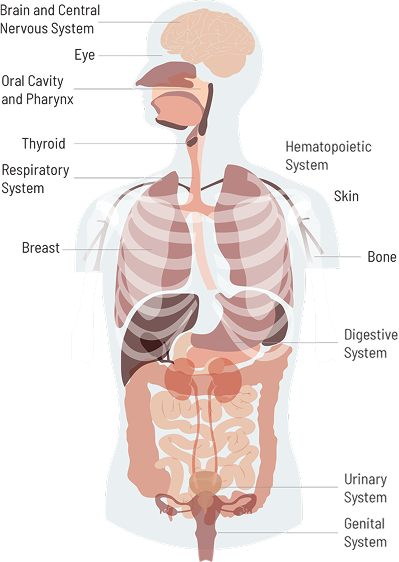Human Carcinogens
Almost 130 agents have been classified as having sufficient evidence to cause cancer in humans.
The IARC Monographs identify the causes of human cancer. Sometimes called the World Health Organization’s “Encyclopedia of Carcinogens,” the IARC Monographs are systematic evaluations of the strength of evidence that an agent can cause cancer in humans. Since the program’s inception in 1971, over 1,040 agents have been evaluated, including chemicals, complex mixtures, physical and biological agents, personal habits, and occupational exposures.
The agents are classified as carcinogenic to humans (Group 1), probably carcinogenic to humans (Group 2A), possibly carcinogenic to humans (Group 2B), or not classifiable as to their carcinogenicity to humans (Group 3). This classification, based on publicly available scientific literature, reflects evidence derived from studies of cancer in humans, cancer in experimental animals, and studies on carcinogen mechanisms in exposed humans, experimental animals, and in-vitro systems. Evidence from human and animal studies of cancer is considered as sufficient, limited, inadequate, or suggesting lack of carcinogenicity. Mechanistic evidence from in-vitro studies is considered as strong, limited, or inadequate, based on the key characteristics of carcinogens. To date, 129 agents have been classified in Group 1, mainly on the basis of sufficient evidence from epidemiological studies that the agent can cause one or more cancer types in humans, and with some agents classified based on sufficient evidence for cancer in experimental animals and strong evidence in exposed humans for the key characteristics of carcinogens.
Some important risk factors for cancer in humans have not been evaluated by the Monographs program, notably genetic traits, reproductive status, and other diseases (e.g., diabetes), while certain protective factors, such as weight control, physical activity, or reduction of alcohol consumption (see Body Fatness, Physical Activity, and Diet and Alcohol) have been evaluated by the IARC Handbooks. However, excess body fatness and sedentary behavior may be topics of future Monographs evaluations.
Figure 3.1 shows which agent(s) have sufficient evidence of causing cancer for each organ or group of organs in the human body.
Group 1 (carcinogenic to humans) agents by target organ site
The number of such agents for the most common cancer types (lung, breast, colorectum, prostate, stomach, and liver) is highly variable. For example, there are 32 known causes of lung cancer, but no known causes of prostate cancer identified by the Monographs program. Over 40 agents cause cancer in more than one target organ site, with tobacco causing cancer in 17 sites and X-radiation and gamma-radiation in 14 sites (Figure 3.2).
Over 40 agents cause cancer in more than one target organ site with tobacco causing cancer in 17 sites.
IARC Monograph Group 1 (carcinogenic to humans) agents associated with four or more cancer types, 2024
Footnote
Major cancer site groupings: some types are combined.
